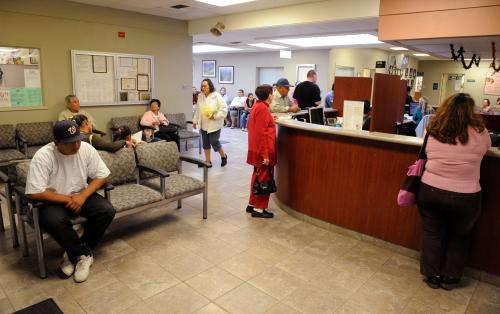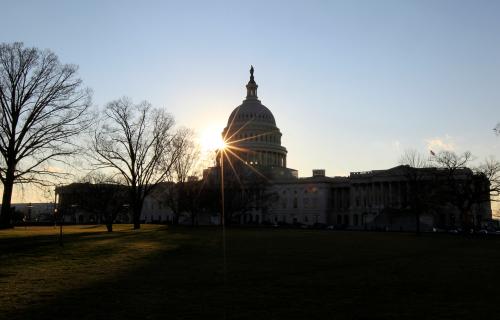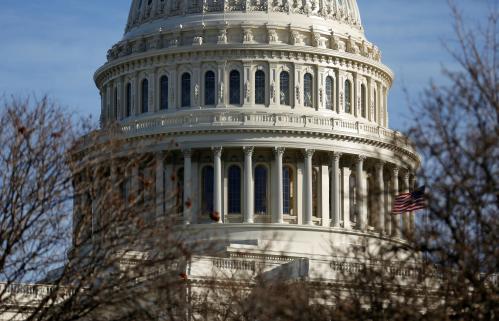This analysis is part of USC-Brookings Schaeffer Initiative on Health Policy, which is a partnership between the Center for Health Policy at Brookings and the University of Southern California Schaeffer Center for Health Policy & Economics. The Initiative aims to inform the national health care debate with rigorous, evidence-based analysis leading to practical recommendations using the collaborative strengths of USC and Brookings.
“Surprise” out-of-network bills are widely seen as an unfair aspect of today’s health care markets. Patients are unfairly surprised when they are billed by a provider not in their insurer’s network where they had no reasonable opportunity to choose a network provider. Not only are these patients charged the full, not-negotiated “chargemaster” rate, they usually must also must pay a greater portion of the charges because it is out-of-network care.
Complete up-to-date Brookings’ resources on surprise billing are available here. Recent work includes:
- What is surprise billing?
- Rep. Ruiz’s arbitration proposal for surprise billing (H.R. 3502) would lead to much higher costs and deficits
- Federal surprise billing legislation does not violate the constitution
- Network matching: An attractive solution to surprise billing
In addition, the balance bill they pay typically is not protected by the insurance plan’s maximum out-of-pocket (commonly referred to by policy wonks as a “MOOP”) limit. Both blue and red states have already started taking steps to protect consumers from these potentially devastating bills, but as we have outlined before, federal action is needed to protect all American consumers. The following two federal actions could offer distinct forms of protection from surprise bills – from requiring that any amount paid toward a surprise bill must count toward the maximum out-of-pocket limit to holding patients financially harmless for any cost above in-network amounts. In this blog, we explain the details of each action, and discuss the merits, risks, and limitations of these reforms.
| Patient Protections from Surprise Out-of-Network Bills | ||
|---|---|---|
| Emergency Care | ||
| 2018 ACA Benefit and Payment Parameter Rule | The Patient Freedom Act | |
| Applies In-Network Cost Sharing (Co-pays, Coinsurance, and Deductibles) | The ACA requires that insurers limit to in-network rates the cost sharing they charge patients for emergency care, but the ACA does not limit what providers may balance bill patients for this care. | |
| Limits Insurer Liability | The ACA outlines what insurers must pay toward out-of-network emergency care. | |
| Limits Patient Liability | Partially | Partially |
| Prohibits Balance Billing | No | Partially |
| Non-Emergency Care | ||
| Applies In-Network Cost Sharing (Co-pays, Coinsurance, and Deductibles) | No | No |
| Limits Insurer Liability | No | No |
| Limits Patient Liability | Partially | No |
| Prohibits Balance Billing | No | No |
2018 ACA Benefit and Payment Parameter Rule
The ACA prevents all but grandfathered health plans from charging patients any more than their standard in-network cost sharing amounts for emergency care. However, the ACA does not prevent emergency care providers themselves from balance billing patients, and it has no protection for surprise billing for non-emergency care. However, in setting requirements to maintain “qualified health plan” (QHP) status in the federal or state exchanges, the Centers for Medicare and Medicaid Services (CMS) issues a “benefit and payment parameter” rule each year that contains modest additional protections. The 2018 rule (page 89) does so by requiring that patient cost sharing for certain surprise bills at least count toward a health plan’s maximum out-of-pocket limit.
Normally, health plans are required to count only in-network cost sharing toward the maximum out-of-pocket limit, and in fact, 45 percent of silver-level PPO plans sold on the exchange in 2015 lacked an out-of-pocket maximum for out-of-network (OON) care. However, CMS’s 2018 rule requires all QHPs in the individual market to count OON cost sharing toward the beneficiary’s maximum out-of-pocket limit if it is delivered by an ancillary provider at an in-network facility (e.g., radiologist, anesthesiology, pathologist), absent advanced notice of the potential charge. This rule applies even if the particular QHP does not include any OON coverage at all. While patients have some opportunity to select the primary provider for in-hospital care, such as a surgeon, they have little ability to choose the ancillary providers seen in that setting or ensure that those providers are in their insurer’s network. This rule aims to give greater financial protection to the patient going in for knee surgery who subsequently receives a large bill for the related anesthesiology services unknowingly delivered by an out-of-network provider, by requiring that these charges at least count toward the patient’s maximum out-of-pocket limit for the year. This is notable because QHPs are not required to cap beneficiaries’ expenses on OON care. Another merit of the rule is that it applies to multiple care settings: emergency, in-network hospital, and in-network non-hospital facilities (such as surgery centers). The CMS rule has significant limitations, however, many of which are readily acknowledged in its language and attributed to limited authority through rulemaking. First and foremost, the rule still leaves beneficiaries liable to pay the relevant cost sharing, up to their maximum out-of-pocket limit, and does nothing to prevent providers from balance billing a patient for the full remainder of the bill (the amount above what is paid by the insurer and required patient cost sharing).
Additionally, the “adequate notice” provision could prove more problematic than helpful. The rule allows plans to disregard OON charges if they adequately notify beneficiaries in advance of the potential for OON charges. “Adequate notice” is defined as “the longer of when the issuer would typically respond to a prior authorization request timely submitted or by 48 hours before the provision of the benefit.” Importantly, plans are not required to give a cost estimate and thus patients end up assuming the financial risk without information essential to understanding the implications of agreeing to receive out-of-network care.
The surprise bill provision of the Cassidy-Collins’ Patient Freedom Act
The Patient Freedom Act of 2017 is one of the bills pending in Congress to reform the ACA. Tucked in this particular bill is a provision that protects patients from surprise medical billing in emergencies, simply by limiting the amount an out-of-network provider can charge (although this would not pre-empt existing state protections). The bill outlines these limits by category of service: 85 percent of usual, customary, and reasonable rates (UCR) for physician services, as defined by the insurance department of the state in which services were furnished; 110 percent of traditional Medicare rates for hospital services; and, for drugs and biologics, the lesser of two times the acquisition cost or acquisition cost plus $250.
By capping the total amount a provider can collect, the bill would complement the ACA’s beneficiary protection, which sets an amount that the insurer must pay a provider for emergency care. Instead of potentially being liable for an exorbitant balance bill for emergency care under current law, the Cassidy-Collins bill would limit this liability to the difference between the mandated insurer payment amount and the provider payment cap set in the bill. This change would provide significant, though not complete, protection from large surprise OON bills for patients, while preventing adverse impacts that might ensue with no limit on provider payment. Importantly, though, the provision does not technically ban balance billing. While the provision limits the amount that providers can charge, and ACA protections dictate an amount the insurer must pay the provider, if the Patient Freedom Act’s provider charge limit is greater than the ACA-determined insurer payment rate, the patient may be balance billed the difference. Interestingly, under the provider payment limits set by the Cassidy-Collins bill, this potential balance billing liability is likely to exist only for physician services – where 85 percent of the UCR might exceed what an insurer normally pays OON – but present almost no difficulty for hospital services – where 110 percent of Medicare FFS rates is typically much lower than OON amounts allowed by insurers. While this largely solves the surprise billing problem for emergency care, the bill does not address non-emergency care settings, another significant source of surprise bills. As a result, a woman giving birth may still be charged the full OON rate for her anesthesiologist during birth, or a man having neck surgery for his consulting surgeon.
Conclusion
Each of these federal actions can lessen the risk or mitigate the impact of surprise medical bills for insured Americans, a problem that has long plagued private health insurance beneficiaries in America, but individually will not completely protect consumers. As we have recommended before, a more comprehensive federal solution is necessary to protect consumers from balance billing. Any solution should cover emergency and non-emergency services, patients should be held completely harmless beyond normal cost sharing, and payment guidelines and dispute resolution process should be clearly outlined for physicians, hospitals, and insurers. Update: After closer examination of the legislative language in the End Surprise Billing Act of 2017, the bill’s intents and impacts are unclear, and as such, this blog’s discussion of that bill has been removed.












Commentary
Receive a surprise medical bill? Here are two federal actions that may address surprise bills
August 8, 2017